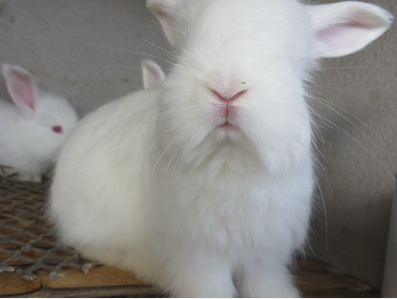1、坚持自繁自养,新购兔隔离观察为了防止传染病的侵入,自繁自养,确需引种时,要从非疫区购买。购入后隔离饲养2周以上,确认无病后方可放入兔场饲养。
1. Adhere to self breeding and self cultivation, and observe the isolation of newly purchased rabbits. In order to prevent the invasion of infectious diseases, self breeding and self cultivation are necessary. When it is necessary to introduce, it is necessary to purchase from non epidemic areas. After purchase, quarantine and raise for at least 2 weeks, and confirm that there are no diseases before placing them in a rabbit farm for breeding.
2、搞好卫生卫生是防病的重要一环,通过以减少和消灭环境中的病原体,切断传播途径。饲养人员要求在更衣、换鞋、洗手后进入兔舍,进入场区的大门口应设池。外来工具、物品要经后再使用,常用工具及时清洗和曝晒。兔舍、兔笼要坚持每天清扫一次,每周带兔一次。
2. Doing a good job in hygiene and disinfection is an important part of disease prevention. Through disinfection, pathogens in the environment can be reduced and eliminated, and transmission routes can be cut off. Breeding personnel are required to enter the rabbit shed after changing clothes, shoes, and washing hands, and a disinfection pool should be set up at the entrance to the site. External tools and items should be disinfected before use, and commonly used tools should be cleaned, disinfected, and exposed to sunlight in a timely manner. The rabbit shed and rabbit cage should be cleaned once a day and disinfected with rabbits once a week.
3、搞好免疫免疫是控制传染病发生的一种重要手段,免疫搞好了,疫病就能得到有效的控制。由于各地区、各兔场的疫病流行情况不同,因此也就不可能有一个可供各地统一使用的免疫程序,这就需要各养兔场在实践中总结经验,制定符合具体情况的佳免疫程序。
3. Immunization is an important means of controlling the occurrence of infectious diseases. Once immunization is done well, the epidemic can be effectively controlled. Due to the different epidemic situations in different regions and rabbit farms, it is impossible to have a unified immunization program that can be used by various regions. This requires each rabbit farm to summarize their experience in practice and develop optimal immunization programs that are tailored to the specific situation.
下面是几种常见病的免疫方法:
The following are immune methods for several common diseases:
兔瘟。仔兔40~45日龄皮下注射兔瘟蜂胶疫苗1毫升或兔瘟-巴氏杆菌二联苗2毫升,在60日龄时再加强免疫接种一次,以后每6个月免疫注射一次。若本病发生流行,在流行地区需加倍剂量免疫接种。
Rabbit plague. Rabbits aged 40-45 days were subcutaneously injected with 1 milliliter of rabbit distemper propolis vaccine or 2 milliliters of rabbit distemper Pasteurella vaccine. At 60 days of age, they were further vaccinated, followed by immunization every 6 months thereafter. If this disease becomes prevalent, double the dose of immunization is required in the epidemic area.

兔巴氏杆菌病。仔兔断奶后每只注射兔禽巴氏杆菌苗1毫升或兔瘟-巴氏杆菌二联苗2毫升,以后每4个月注射一次。
Rabbit pasteurellosis. After weaning, each rabbit is injected with 1 milliliter of Pasteurella rabbit avian vaccine or 2 milliliters of Pasteurella rabbit distemper combined vaccine, and thereafter every 4 months.
魏氏梭菌病。断奶仔兔皮下注射魏氏梭菌苗2毫升,以后每5~6个月免疫注射一次。
Clostridium welchii disease. Weaned rabbits were subcutaneously injected with 2 milliliters of Clostridium welchii vaccine, and subsequently immunized every 5-6 months.
大肠杆菌病。仔兔20日龄开始注射大肠杆菌多价菌,每次皮下注射1毫升,待仔兔断奶后再免疫一次,皮下注射2毫升,以后每4个月免疫一次。
Colibacillosis. At the age of 20 days, the newborn rabbits were injected with polyvalent Escherichia coli, 1 ml of which was injected subcutaneously each time. After weaning, the newborn rabbits were immunized again, 2 ml of which were injected subcutaneously, and then immunized every 4 months.
波氏杆菌病。仔兔18日龄皮下注射波氏杆菌病菌苗1毫升,一周后强化免疫,皮下注射2毫升,以后每4个月注射一次。
Bordetellosis. At the age of 18 days, the rabbits were subcutaneously injected with 1 milliliter of the Bordetella vaccine, followed by a week of booster immunization and 2 milliliters subcutaneously. Afterwards, they were injected every 4 months.
葡萄球菌病。在母兔配种前皮下注射葡萄球菌病菌苗2毫升,保护期为4个月。
Staphylococcal disease. Subcutaneously inject 2ml of Staphylococcus aureus vaccine into the mother rabbit before mating, with a protection period of 4 months.
In summer, the temperature is high, the humidity is high, and the bacteria multiply quickly. It is necessary to keep the rabbit house clean and hygienic, ensuring that the rabbit cage is frequently cleaned, the bottom plate is frequently replaced, feces are frequently cleaned, and feeding utensils are frequently disinfected to prevent the spread of diseases. For more related matters, come to our website http://www.myxinhua.com Consult!


 发布日期:2023-05-31
来源:http://www.myxinhua.com 发布人:admin
发布日期:2023-05-31
来源:http://www.myxinhua.com 发布人:admin